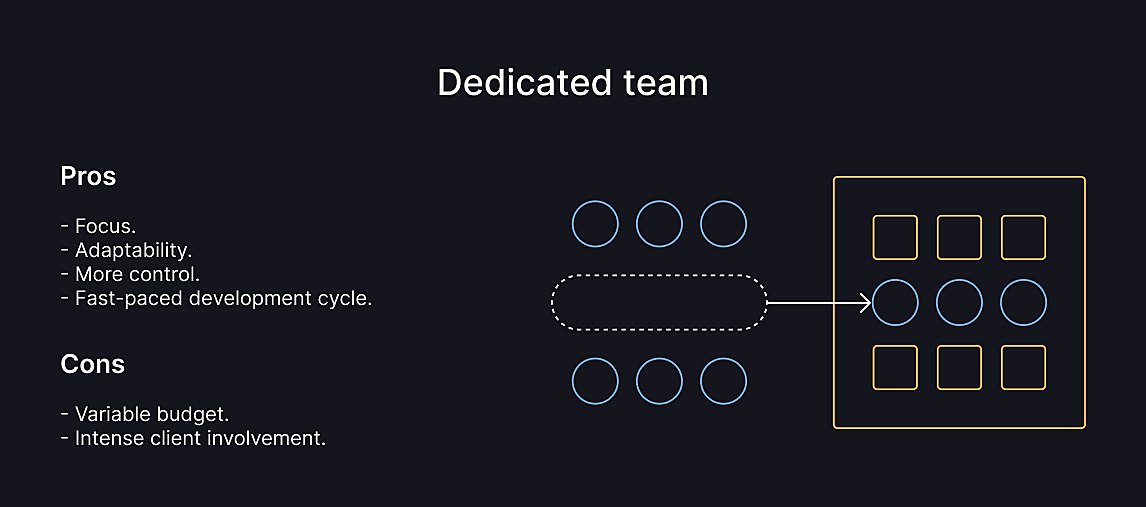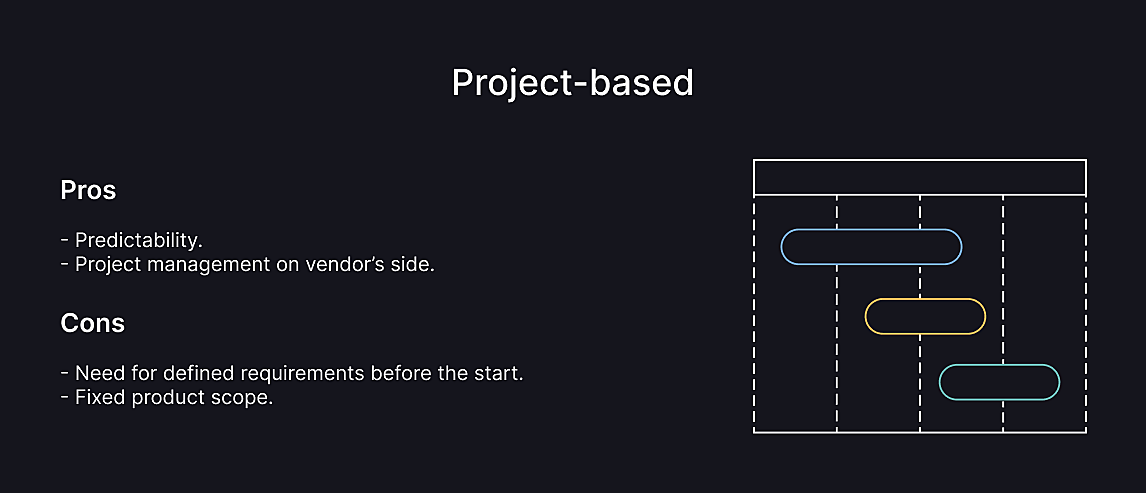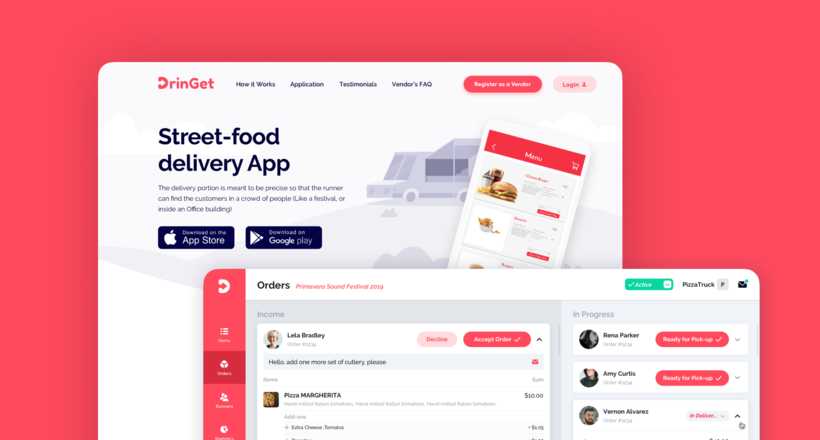
According to Statista, the total value of information technology outsourcing contracts is $66.5 billion. In one of our recent articles, we talked about outsourcing software development as a response to a crisis. There is no universal outsourcing engagement model to match every company's needs. It’s time to look closer into the types of outsourcing models and explain the ones we offer at Agente.
In this post, we talk about various types of outsourcing models in regards to location and client–outsourcer relationships.
Location-based engagement types
Each engagement model in software development discussed below can be performed either onsite, onshore, nearshore, or offshore.
- On site: A service provider sends skilled professionals to work in your office for a fixed period of time.
- Onshore: A company outsources services to a provider within the same country but outside the company.
- Nearshore: Services are outsourced to a provider in a neighboring or nearby country (e.g., in the same time zone).
- Offshore: A company outsources services to a provider in a distant country.
Agente experience:
Agente can send specialists to a client during a discovery project phase (to run a workshop, get to know the stakeholders, and make user research). However, if the services you require can be performed distantly (e.g., design, software development), there’s no need for the onsite presence of specialists, especially post the COVID-19 pandemic, when any unnecessary human contact should be avoided.
We practice a number of product development engagement models in outsourcing giving the customer freedom to shape our business relationship.
Types of Outsourcing Engagement Models
IT outsourcing engagement models are divided into four types: dedicated team, project-based, product as a service, and single service.
Dedicated team
In this case, a remote team from the service provider is dedicated to the realization of your project. The dedicated team works on a certain project exclusively full-time with direct reporting to the client. We are responsible for recruiting services, administrative support, and all the resources for the realization of the project.
What is the client’s role, then? The company interacts with the team, monitors daily activities, and stays current with the overall progress of the project.

How does it work?
Step 1. The product owner and product manager from the client company outline the services, number of employees and skills required for the project.
Step 2. We hire a dedicated team that corresponds to these requirements.
Step 3. The team and the client agree on the workload, project requirements and the timeframe.
Step 4. The dedicated team starts working. The product owner and product manager from the client’s side have full management control over the project.
Pros
- Focus: Skilled professionals are concerned with realizing one project which increases the speed and quality of results.
- Adaptability: The dedicated team model allows the team to reconfigure at every stage of the project according to the current needs and requirements.
- More control: The client has full control over the selection of candidates and the management of dedicated team members.
- Fast-paced development cycle. A more hands-on approach from the client and a focused development team allow the whole process to proceed at a higher pace. A project can also be started faster with incomplete requirements.
Cons
- Variable budget. You can’t determine all the costs at the start of the project. That’s why clients need to plan their budget taking into account extra expenses.
- Intense client involvement. Project owners and managers become part of the team. They need to be completely involved in the selection of team members and they have to communicate with the dedicated team members on a regular basis.
Agente Experience
Our dedicated team consisting of PM and UX/UI re-designed an online learning system Automation Academy by Workfusion. First, we analyzed project requirements and re-built the information architecture and user flow of the Moodle-based LMS to add a fresh touch to the interface by drawing custom illustrations.
Project-based
With a project-based software development model of engagement, the client specifies an exact scope of work and timeline before the project starts. Agente takes on the responsibilities for development and project management. In other words, we become a technical solution provider. Any change requests are discussed separately and charged over budget.
This model fits you perfectly if you require work that can be provided with a very quick turnaround, you have a clear business vision for the product, have a fixed budget, and know your timeframe. We can oversee the whole scope of work and requirements and will deliver your product within a strictly defined timeline.

How does it work?
Our software developers and designers do all the scope of work involved in the client’s project, including UX,UI, frontend, backend, API integration, testing, and bug fixing.
Pros
- Visibility. This outsourcing model of engagement gives you predictions in terms of project deadlines as all the requirements are written before the project starts. All of the deadlines are approved by the client so you know how your project will progress over time and when it will be completed with accuracy.
- Less management from the client side. This can actually be used as pros and as cons, depending on a client’s needs. Compared to other types of outsourcing engagement models, this one requires less management and supervision by the client, as the development team is defined and the scope of work and budget are already known.
Cons
- Need for defined requirements before the start.
- Fixed product scope. Anything beyond the scope should be paid over budget.
Agente Experience
One of our project-based cases is FQ, a health-minded fitness app. We conducted deep UX research, UX/UI design, and a fully-fledged and feature-packed native iOS application with recommendations on nutrition and training, subscriptions, weight-tracking, sharing progress with other users, etc.
Product as a service
We are fully responsible for the product from A to Z. We establish a product development team and create a turnkey solution for you, from design and planning to development and support. There is no need for project management from the customer’s side. If you want a better understanding of the process, read our article and find out how to build an NFT marketplace from scratch.

How does it work?
Step 1. This a discovery phase, in which we gather information about your product: Business problems you want to solve, budget, timeframe, users.
Step 2. On the basis of this information, our business analyst finds a technical solution that will suit the case. Our software developers define a suitable technology stack and our designers create wireframes to demonstrate UX.
Step 3. We create the product: UI, frontend, backend, API integration, testing, bug fixing. Our team follows the agile methodology and provides an estimate for the scope to the client.
Step 4. This is an optional step where we maintain the product after launch. It requires signing a separate contract which typically extends over several months.
Pros
-
No need for defined requirements. We do estimations, tell you how to run a design workshop, and identify product goals.
- No need for product management on the client side.
Cons
- The long preparation phase, so it’s not the best option if you have time constraints.
- No exact budget. It’s difficult to estimate the maximum budget.
Agente Experience
Agente’s team has successfully launched a crypto-tracking plug-in called Cointube. It’s a new-tab extension for the Chrome browser that aggregates the latest data for the cryptocurrency, such as crypto news, data on ICO, portfolio tracking, etc.
Single-service
A single-service or on-demand outsourcing model provides the client with a possibility of paying for a particular service. For example, Agente provides you with a specific service that is not available in-house. The services include usability auditing, product design, and web/mobile development or testing. The team and the delivery process is managed on our side.

How does it work?
A client buys a number of hours that will be spent on any of the services that Agente provides. Such a project is billed for actual work scope based on hourly rates of employees, plus the costs of materials. The main advantage of the single service model is the opportunity to get the specific expertise that your team lacks and adjust requirements, while the vendor provides their quality services.
Pros
- Requirements can be updated on-the-go.
- Task implementation on demand.
- The team is highly skilled in a specific service.
Cons
- There are no defined deadlines.
- Requires client involvement.
- The minimum engagement is 20 hours.
Agente Experience
One of our single service challenges was to provide a full UX/UI design service for DrinGet, a food ordering app. We ideated and designed a food ordering app with a user-friendly interface: We created wireframes and user experience and worked out branding and logo design to make the app more recognizable.
Let’s compare Engagement Models for Software Outsourcing
In this section, we’ve made a table comparing the models in outsourcing against the most critical parameters: scope of work, budget, and communication.
Remember that every project requires a unique approach to understand what engagement model fits best. It depends on the longevity and complexity of requirements, client involvement and communication, and tactical and strategic plans of the client company.

Contract types in software development outsourcing
So, what about billing? Let's take a look at how the above-mentioned software development engagement models can be billed. The main contract types are time and materials (T&M) and fixed-price contracts.
Time and Materials
Under the T&M contract, you pay for the work and the expertise of the development team. In this case, the project is billed at the rate based on actual time spent by designers/developers. It doesn’t have a rigid end date and scope. It gives the opportunity to scale development up and down, or to terminate the cooperation.
T&M is good to use where it is impossible to determine the full scope of work. It fits the following projects:
- When the project is at the stage of testing, maintenance, or revision. This model is a very convenient option for performing individual blocks of work.
- Projects that take up to six months, for a team of five people and require technical documentation. The T&M model allows the contractor to adapt to the wishes of the client and the requirements of the market.
- Large projects that take a year to develop and require a team of 20 people. Due to the large volumes and long development time, preliminary specifications will take thousands of pages, which will be adjusted during development.
Fixed Price
When you choose a fixed-price contract, you agree on the final cost of a product or service upfront. This price is written into a contract that both parties sign. How long the fixed price lasts depends on the terms of the contract.
Fixed-price agreements work better:
- for projects with a defined scope
- for shorter-term projects.
How to Choose the Outsourcing Engagement Model for Your Project
Choosing between engagement models in software development may seem puzzling. We are here to help you out. To decide on the best model to suit your project, answer the following questions:
- What is the type of your project? Is it simple or complex?
- Do you want to be able to change requirements in the process of product development?
- Do you have the competence to control the software development process yourself or would you rather delegate it to the contractor?
- Do you have a strict and predictable budget? Does it need to be fit-in?
- Should the project be carried out as soon as possible, or are there no time restrictions?
- Do you have any specific release date in mind?
Final Thoughts
The choice of the contract type, as well as the engagement model, depends on the requirements of the specific project you'd like to outsource. Contact us and we'll consult you on what fits you best
Frequently Asked Questions
What are the downsides of the T&M and fixed-price product development engagement model?
With the T&M model, the final cost of the software project is not defined and can be unexpectedly high. The downside of the fixed-price model is that it is very rigid when it comes to changes; sometimes it even requires changes in the contract.
What is the notice period for the T&M outsourcing engagement model?
If you want to cease cooperation with your contractor, the notice period is typically from the moment of the decision until the last day of the following month.
Why go for software outsourcing?
Outsourcing is the best decision when you don't have time to attract the right specialists and gather an in-house team.
What is the main difference between the product-as-a-service and the single-service engagement model in software development?
In the case of the product-as-a-service model, you get a turnkey-ready product. With a single-service outsourcing model, you can choose only one service, for example design, development, or testing that is not available in house.
What is the best software development model of engagement?
There is no one-size-fits-all engagement model that will be identically effective in every project. The choice depends on the budget, and project scope, as well as the desire to control the process and deadlines.
Rate this post!
916 ratings, average ratings is 4.8 out of 5
Related Posts

Effective Food Delivery App: Key Tips & Best Practices
In this article, we will share our experience in creating a design for a specialized food delivery management software, as well as best practices in designing such an application.

02 August 2023
E-learning Platform Development: Features & Steps to Build
Build an online learning platform with ease: A guide to essential features and step-by-step processes for successful e-learning platform development.

07 May 2021
How to Integrate 3D Models into Web Apps
We discuss the value of 3D models to your business, pick things to consider before collaborating with your IT partner, and look at 3D web apps.

29 April 2021
Why Use Ruby on Rails and How Can It Benefit Your Next Product?
Learn when to use Ruby on Rails framework for the backend of your app or website and how to choose web developers who use Ruby on Rails programming language.

06 November 2020
Dedicated Team Model: What It Is, Pros & Cons for Your Project
Dedicated team model - a winning approach to scaling your project fast when done right. Find out pros and cons and how to find a dedicated software team that will fit your needs

18 November 2019
10 Best Web Development Tools
Get to know the best web development tools for web designers who want to save their time and improve the quality of the final product.
Let's talk
Is there a challenge your organization or company needs help solving? We’d love to discuss it.

Managing Director, Partner
Andrew Terehin

Thank You!
Your message has been successfully sent.
We will contact you very soon.






